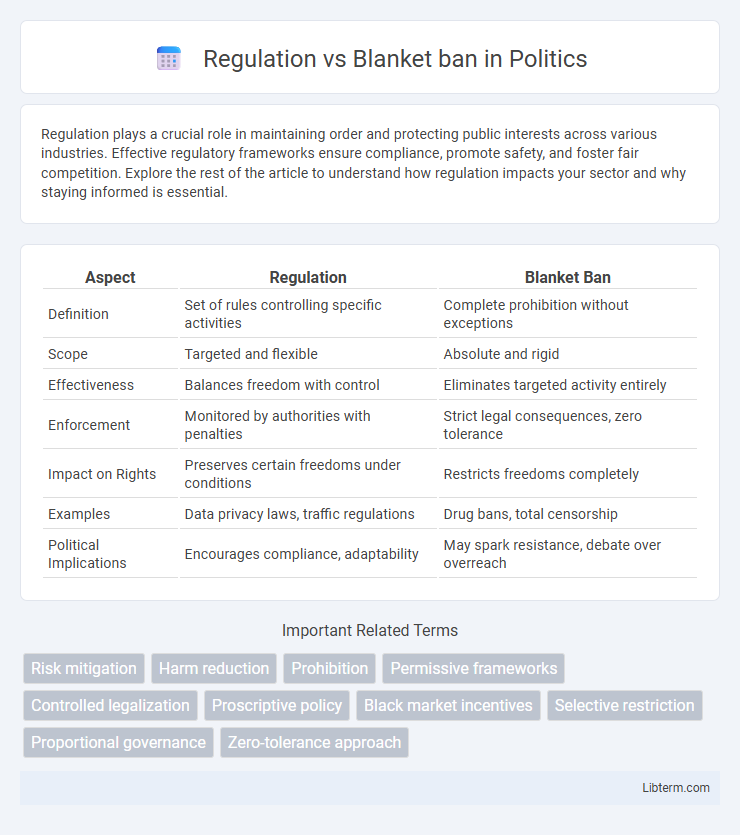Regulation plays a crucial role in maintaining order and protecting public interests across various industries. Effective regulatory frameworks ensure compliance, promote safety, and foster fair competition. Explore the rest of the article to understand how regulation impacts your sector and why staying informed is essential.
Table of Comparison
| Aspect | Regulation | Blanket Ban |
|---|---|---|
| Definition | Set of rules controlling specific activities | Complete prohibition without exceptions |
| Scope | Targeted and flexible | Absolute and rigid |
| Effectiveness | Balances freedom with control | Eliminates targeted activity entirely |
| Enforcement | Monitored by authorities with penalties | Strict legal consequences, zero tolerance |
| Impact on Rights | Preserves certain freedoms under conditions | Restricts freedoms completely |
| Examples | Data privacy laws, traffic regulations | Drug bans, total censorship |
| Political Implications | Encourages compliance, adaptability | May spark resistance, debate over overreach |
Understanding Regulation and Blanket Bans
Regulation involves creating specific rules and guidelines that control activities while allowing for flexibility and compliance monitoring, ensuring businesses and individuals can operate within defined limits. Blanket bans prohibit entire categories of activities or items without exceptions, creating clear but rigid restrictions that make enforcement straightforward but may also overlook context or nuance. Understanding the balance between targeted regulation and broad prohibition is essential for effective policy-making that addresses public safety, environmental concerns, or social issues comprehensively.
Key Differences Between Regulation and Blanket Bans
Regulation imposes specific rules or guidelines that entities must follow, allowing controlled and conditional activities, whereas a blanket ban prohibits an activity entirely without exceptions. Regulations often involve monitoring, compliance mechanisms, and penalties for violations, providing flexibility to balance benefits and risks. Blanket bans eliminate all legal engagement with the banned activity, prioritizing absolute restriction over nuanced management.
The Pros and Cons of Regulatory Approaches
Regulation allows for tailored rules that balance safety and innovation, minimizing economic disruption while protecting public interests. However, it can lead to complex compliance requirements and potential loopholes that undermine effectiveness. Blanket bans offer clear, enforceable prohibitions that eliminate specific risks but may stifle technological progress and impose broad restrictions affecting diverse stakeholders.
The Impact of Blanket Bans on Society
Blanket bans often generate significant social and economic disruption by imposing broad prohibitions without considering nuanced circumstances, which can stifle innovation and limit individual freedoms. Unlike targeted regulations that balance risk management with practical application, blanket bans may create underground markets and reduce compliance, exacerbating societal issues instead of resolving them. Evidence from public policy studies highlights that nuanced regulations tend to yield better long-term outcomes by addressing specific concerns while preserving societal functionality.
Case Studies: Regulation vs Blanket Ban in Key Sectors
Case studies in key sectors reveal that regulation offers targeted measures allowing flexibility and innovation, whereas blanket bans impose strict prohibitions often leading to unintended economic and social consequences. For example, in the tech industry, GDPR regulation balances user privacy with business needs, contrasting sharply with China's blanket ban on certain foreign apps which stifles market competition and consumer choice. Environmental policy case studies, like the EU's regulated emissions framework, demonstrate effectiveness over absolute bans by incentivizing sustainable practices without halting industrial progress.
Economic Implications of Regulatory Policies
Regulation allows targeted control over industries, balancing economic growth with risk management by setting specific standards that businesses must follow, thus fostering innovation and competition. Blanket bans can lead to market distortions, job losses, and reduced consumer choice by completely prohibiting certain products or activities without flexibility for adaptation or improvement. Economic implications of regulatory policies often include cost-benefit analysis, with regulations aiming to minimize negative externalities while maximizing market efficiency and social welfare.
Legal Challenges with Blanket Bans
Blanket bans frequently face significant legal challenges due to their overly broad nature, often infringing on constitutional rights such as freedom of speech or commerce. Courts scrutinize blanket prohibitions for failing to provide nuanced distinctions, which can lead to rulings that these bans are arbitrary or discriminatory. Legal precedent emphasizes the necessity for regulations to be narrowly tailored and evidence-based, contrasting with the sweeping impact of blanket bans.
Public Safety: Regulation or Blanket Ban?
Regulating substances or behaviors allows for controlled use with safety standards, minimizing risks while maintaining personal freedoms. Blanket bans eliminate all access, potentially reducing public harm quickly but often driving activities underground, complicating enforcement and risk management. Effective public safety balances targeted regulations with enforcement strategies to mitigate harm without fostering illicit markets.
International Perspectives on Regulation and Blanket Bans
International perspectives on regulation and blanket bans reveal varied approaches to controlling products and behaviors across countries. Some nations favor targeted regulations that allow flexibility, such as the European Union's comprehensive data privacy laws, while others implement blanket bans to eliminate specific risks outright, exemplified by several countries prohibiting plastic bags or certain pesticides. The effectiveness of these strategies depends on enforcement capacity, cultural acceptance, and economic impact considerations within each jurisdiction.
Finding the Right Balance: Toward Effective Policy Solutions
Finding the right balance between regulation and blanket bans requires nuanced policy solutions that consider economic impact, environmental sustainability, and social equity. Targeted regulations allow for flexibility and innovation while addressing specific harms, whereas blanket bans can provide clear, enforceable limits but may overlook context-specific factors. Effective policy solutions integrate stakeholder input, empirical evidence, and adaptive frameworks to optimize both protection and practicality.
Regulation Infographic

 libterm.com
libterm.com